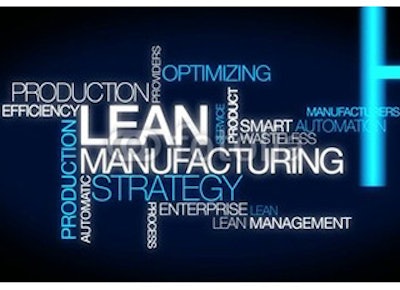
Pennies still matter in the food industry. The smallest of cost improvements is a big deal and can make a major impact on profit margins.
Manufacturers must maximize the utilization of their biggest and best asset — their employees — to drive cost reductions, streamline processes and eliminate waste throughout the entire supply chain. There are several ways food manufactures can optimize production and administrative processes to find new and improved ways of producing and delivering goods at a greater profit.
The Lean Methodology
The core idea of the lean methodology is the elimination of those things that customers do not value or, simply, maximizing value while eliminating waste.
A shift to lean manufacturing moves from the conventional mass production of goods to an aligned, continuous flow of product. In order to make this shift on the production floor, process efficiencies and effectiveness must be thoroughly thought through by management and properly explained to line workers for full execution.
Also See: Learn How to Unlock Hidden Manufacturing Capacity
Manufacturers, however, should not only implement the lean process into the production line, but should consider utilizing within the administration side of business as well. Companies should apply the same lean principles to their accounting, purchasing and IT departments that they apply to the plant floor. Can the purchasing department work with suppliers to reduce lead times for high volume raw materials, resulting in reductions in warehousing space and labor? Is it possible to streamline the invoicing process to improve cash flow and result in less interest expense? The application of lean principles to the back office will result in reduced overhead costs.
As companies implement lean, traditional financial reporting may not provide the meaningful information required to support continuous improvement and, in many cases, may actually impede a company’s progress on its lean journey. Therefore, aligning financial and operational metrics with the lean strategy is critical to success.
Value Add Versus Non-Value Add Activities and Costs
Being able to deliver the right product at the right time to the customer has become a baseline expectation. Food manufacturers should identify and consider their value added activities versus their non-value added activities, or those actions and elements that either add value or those that add no value to the process or product. As both require time and money for an organization, it’s essential for management to determine those factors that benefit the customer, and those factors that add no value and can be considered wasteful. This will, more often than not, increase the organization’s profit margins.
Value added costs are those that directly impact the quality and cost for the customer, such as direct materials, direct labor and machine operating costs. Non-value added costs are operational, regulatory and management controlled waste. By reviewing a process, management should ask whether or not each step adds to the function of the product or meets a customer need. If the answer is no, steps should be taken to properly eliminate or reduce the step or material from the process and decrease additional waste. There are a variety of factors that are considered major waste within a process, including overproduction, disproportions of inventory and stock, material/product defects, transportation and people.
A Case Study in Lean: Material Handling That Measures Up
So, how can a manufacturing organization use the lean principles to improve their process and decrease waste? A Midwestern-based commercial baked goods manufacturer recently recognized the organization’s need to do this, as their process loss was tracking at over 12 percent versus an expected process loss of 6%. Management, unsure of the exact cause of increased loss, decided to identify unnecessary and significant non-value added costs and activities throughout the production process to reduce the overall loss and increase profitability.
The first step was to take a closer look at the current process in order to understand where improvements could be made and where possible steps, materials and time were being wasted. By informally observing the manufacturing plant line and gathering data from office administration, management determined the two key areas in the production process that needed adjustments, both of which were considered a non-value add for their customers and the end consumer.
First, it came to management’s attention that there was substantial raw material loss happening on the production floor. They realized that line employees were estimating ingredient portions rather than measuring exact amounts, and there was no accountability on the line workers to record these measurements during the process either. After data gathering, it was determined that this non-adherence to the formula and exact measurements made up for nearly 2.5 percent of the process loss experienced on the line. This alone accounted for a significant amount of raw material loss and waste, and could have caused regulatory issues as the specific formula for each product resulted in the good’s nutritional label.
Secondly, line workers were not properly handling and storing inventory, which would cause small spills or additional product loss throughout the process. While each spill seemed minor enough to not record or consider, each incident added up to substantial product loss throughout the observation period.
Also See: Extending Lean Labor to the Back Office
Following the observation period, management developed a solution to mitigate both issues identified, and, in turn, reduce product waste. Management brought awareness of the issues to the line workers and the impact not adhering to formula and improperly handling material was having on the process and the organization’s bottom line. They implemented a new step in the process that required recording measurements and material spills to properly keep track of raw materials used in production. Through this implementation, the organization saw an improvement to its gross margin of approximately 4.5 percent over time, which translated into a bottom line improvement of nearly $750,000 annually.
Taking the Right Steps
Spending a bit of time observing, reviewing and analyzing process can allow a manufacturer to significantly reduce waste and lead time, improve line productivity and product quality, enhance employee morale and communication, and increase profit margin. Below are a few examples of ways manufacturers can use lean to begin making a difference in their processes:
- Perform a process assessment by observing the plant floor and shipping and delivery departments. Examine all of the steps in the process from raw materials to the finished product to packaging and shipping. Are there points within the process that do not provide value to the end consumer? Can that step or material be eliminated or improved upon?
- Ensure the organization has a standard operating procedure in place that’s as efficient as possible and that all line workers are informed of and adhering to this procedure.
- Don’t just look to improving the production process. Lean principles can be applied to the administrative functions of a manufacturer as well, including accounting, sales and marketing, customer service and IT. Look for job functions and duties that create wasted time and productivity for your office employees.
- Track your results. Develop quarterly goals and standard work checklists. Hold weekly update meetings to continue to inform employees of improvements and encourage proper procedures.
About the author
Rick Feldt, CPA, is a partner in national accounting firm RubinBrown’s Food and Beverage Services Group. Feldt specializes in audit, enterprise risk management consulting, Sarbanes-Oxley engagements, and accounting and reporting issues. He can be contacted at [email protected] or 314.290.3220























